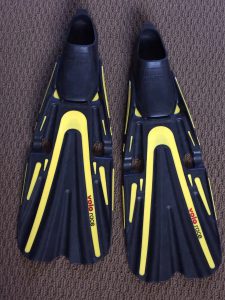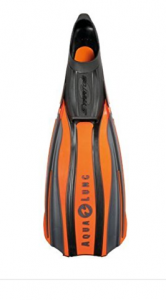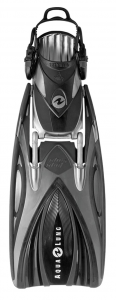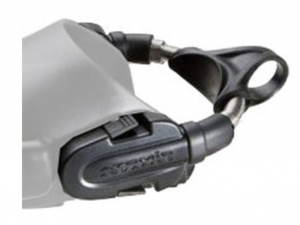 Getting the right type of dive fins is like getting the right tool for the job you want done. They ultimately become your best scuba fins, ones that you will take with you on every dive trip!
Getting the right type of dive fins is like getting the right tool for the job you want done. They ultimately become your best scuba fins, ones that you will take with you on every dive trip!
Not all fins are suited for scuba diving even though there may be similarities. There are different fins for different water sports like free diving, snorkelling, body surfing, swimming and diving.
Why is all this so important? Well .. imagine yourself scuba diving with snorkel fins. As a recreational diver, your depth limit is 130’ which not only makes this a deep dive but even sudden changes in current will be challenging.
Snorkel fins are much lighter, shorter than dive fins, and the ability for propulsion and navigating will be a major issue.
I’m going to give you information on what needs to be considered when you look to invest in your own dive fins. I’ll tell you about the different styles of fins, blade types and their pros and cons to help you decide on which type of fins to take seriously!
Even though you might feel like a penguin, dive fins play a huge role in how you will experience your dives. They’re designed specifically to give you the necessary propulsion and maneuverability as well as to protect yourself from accidentally bumping into coral.
Choosing your dive fins
When it comes to choosing the right dive fins, you need to consider the following:
1) Location and Environment.
If the majority of your dives are going to be in warm tropical waters, you might want to choose the Full Foot Fin. You won’t need to worry about thermal protection on your feet! Not only are they the most popular for divers in the Caribbean, it’s also feels lighter on your feet.
If your dives are mostly in cold water, definitely go with the Open Heel Adjustable Fins and dive boots.
If you do cold water diving as well as warm water diving, you may want to have both the Full Foot Fins and the Open Heel Adjustable Fins with dive boots.
2) Fit and Comfort! Go ahead and try them on!
Much like your dive mask, when choosing dive fins it’s important to get the right fit AND it must feel comfortable on your feet! Having blisters on your feet and strained knees are not pleasant…
Go to your local dive shop, or resort and try the dive fins on. You can also go online and look up the manufacturer’s fin sizing chart.
TIP:
How do you know if you have the proper fitting dive fins?
You should be able to get your foot all the way into the foot pouch and not feel any pinching. Your foot needs to feel comfortable and your toes shouldn’t be touching the material.
If you’re worried about the Full Foot Fins falling off, stand and put your feet in them and raise your heels. If your heels remain in the fins, the fins will not fall off.
If the fins are too tight, you risk getting foot or toe cramps underwater. This might mean getting your dive buddy to massage your foot… and now you’re both not focused on your dive.
If the fins are too loose, you might risk getting blisters on your foot.
3) Your Leg Power. Type of diving!
If you have strong legs, or you’re an experienced diver, or you do deep dives, or cave diving, you might want to consider the stiffer blade open heeled fins. Just be aware, wearing stiffer fins may be exhausting. Some divers wear these for their deep dives to propel themselves upwards… but the fact remains you can’t ascend faster than your bubbles to avoid getting the ‘bends’ (Decompression Sickness)…
Fins that come with sides that are more rigid and have a flexible middle will provide more propulsion power with lesser effort.
Styles of dive fins
Dive fins come in 3 different styles:
 1) Full Foot Fins (Closed Heel Fins)
1) Full Foot Fins (Closed Heel Fins)
These fins are formed for your feet and meant to be worn bare feet. Only the toes are exposed.
PROS:
- Easy to slip into and out.
- Uncomplicated in terms of operation
- Keep your feet in the foot pocket
- Feels lighter than open heel fins
- Easy to do flutter kicks
- No dive boots required.
- Great for warmer water.
- Usually priced cheaper than open heel fins.
- Fits great in your suitcase
Cons:
- Your feet, especially your toes will not feel warm less than 60 degrees F.
- Cannot adjust the fitting.
- If the fitting is not correct, you may experience toe or foot cramps due to pressure on the top of your foot and toes.
These full foot fins must fit you properly, otherwise it may cause mayhem like skin friction and end in blisters.
Some divers wear neoprene diving socks to prevent blisters and protection on bunions. The fin really depends on the shape of your feet.
 2) Open Heel Fins
2) Open Heel Fins
These dive fins are open heeled and your feet are secured in place by straps or buckles.
- The fit – make sure when you wear the fins, the boot needs to fit in the boot pocket of the fins. Refer to manufacturer’s boot size to the shoe size.
PROS:
- Most popular for colder water and deep diving.
- Costs more than full foot fins plus the cost of dive boots.
- Excellent propulsion because of their stiffness.
- Accommodates diving at various sites (cold and warm water).
- Can offer you protection on rough landscapes and act as traction.
- Worn with dive boots or slippers of different sizes for thermal protection.
- Ability to make adjustments at the open heel.
- Can use open heel fins in warm water and save the cost of have two fins.
CONS:
- Feels heavier on the feet.
- Depending on the straps and buckles, adjustments for fitting may be complex.
Variety of Straps and Buckles for Open Heel Fins
 1) Bungee Straps (Spring Straps)
1) Bungee Straps (Spring Straps)
The latest technology… these straps are stretchable and make it easy for you to slide your feet in and out of the Open Heel Fins. Your feet are snuggly secured.
2) Quick adjust buckles
These are buckles that make it easy for the strap to be unlocked. Adjustments are quick. Simply pull on the end of the strap to make the fit tighter.
3) Quick Release Buckle.
This is a quick release of the strap which is located at the outside of the open heel. It allows you to quickly get out of the Open Heel Fin and easily clip the strap back on to secure your foot in the fin.
3) Hand Fins
These are specifically designed gloves that are webbed for our physically challenged divers who are unable to use their legs.
Blade Types
 Split Blade Fin
Split Blade Fin
This split blade is recognized by the slit in the centre. Unlike other blades that push directly against water in full force, this blade allows the water to go thru the slit.
The blades act individually when you flutter kick in tempo which creates a lift and spins water to create a propulsion. Your power comes from the kick.
PROS:
- Less resistance than the traditional paddle fins.
- Easier for the novice diver.
- Can move thru the water easily and quickly as long as you’re not in strong current.
- Most snorkelers love this.
- Relatively newer to the dive industry.
- Propulsion is better
- Great for small flutter kicks and better for forward motion.
- Reduces leg and foot cramps, ankle tiredness and fatigue.
CONS:
- Is not good in strong current, you have to work harder on the kicks, use more energy and air consumption.
- Challenging if you need to back up and take pictures.
- Cannot do alternate kick strokes (i,e. frog kicks).
Paddle Blade Fins
These are the more traditional blade fins and have been around for years. The blade has no split and made out of continuous material like rubber.
Sometimes, you may see them with two holes, one on each side which moves water out to make kicking easier.
PROS:
- Lightweight and comfortable.
- Better than the Split Blade Fin.
- Popular for spear fishing because they offer more speed capability.
- Great for confined spaces like cave diving and cave diving.
- Get better traction.
- Can do alternate kick strokes. Frog kicking and flutter kicking.
- Can get stiffer blades to make diving easier in current.
- Able to do precise direction control such as turning, backing up, frog kicking and sculling.
CONS:
- Because the blade covers a larger surface area, you may experience foot cramping and even knee strains because of it being so solid.
How do you know if your blade is stiff?
1) Hold the fin upright so that your fingers are placed across the open heel foot pocket with the thumb on the back side of the heel. Place your fingers from your other hand under the bottom tip of the blade.
2) Lightly push down on the top of the foot pocket so that it bends 90 degrees. You should be able to maintain that position.
3) If it bends too easily, the fin will not give you enough propulsion.
4) If you’re not able to maintain the blade in a 90 degree angle, then your fins are too stiff making it too difficult to use.
NOTE:
This test will not work on Split Blade Fins. If you’re wondering how rigid, your split blade fins are, just check to see if it has extra material.
Well, I hope I was able to help you out here! If you have any questions or comments about what I wrote or any experiences you have had with your fins, I really would like to hear from you.. please write them below in the comment box!
Come check me out on my review of some actual dive fins!

I will go for the open heel fins with bungy strap adjustment. these seem to be the more robust and powerful fins and no strap holes and buckles to mess around with. Excellent review. Thanks Monica.
Hi Steve,
Thank you for your comment! Glad to hear you’re going with the open heel fins with the bungee straps. They’re definitely stronger than the split fins. I just did a review on the Mares Avanti Quattro Plus with Adjustable Strap fins… http://joyofscubadiving.com/mares-avanti-quattro-plus-adjustable-heel-strap-fins-review-are-they-any-good. If you like check it out and let me know what you think of the Mares.
Amazing informative article. I would’ve never thought so much went into scuba diving fins. I plan on making a beach trip in the summer. If I’m going to do any diving I’ll be sure to use your site as a guide on what to buy for swimming purposes. Thank you and I’ll be sure to bookmark you.
Hi, summer is always a great time to go diving and I hope you get the opportunity to do it. Have a wonderful time!!
Thank you for bookmarking this post!
Hi there, this is a good guide on choosing the best scuba diving equipment. before this I thought you can only get one type of fin but this article sheds some light on different styles and pros and cons of different types.
Very informative information, I will bear this in mind when I do my first dive! thank you
Thank you for your comment! I’m glad you enjoyed reading this! Getting the right dive fins makes a huge difference in how much you enjoy your dives.